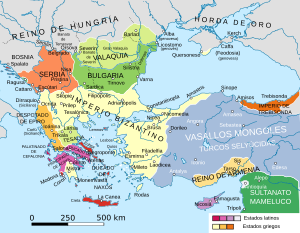Sitio de Berat (1280-1281)
El sitio de Berat en Albania lo realizaron las fuerzas del Reino angevino de Sicilia, que sitiaron a la guarnición bizantina de la ciudad en 1280-1281. Berat era una fortaleza de gran importancia estratégica, cuya posesión les hubiese otorgado a los angevinos acceso al núcleo del Imperio bizantino. Una fuerza de auxilio bizantina llegó en la primavera de 1281, y logró emboscar y capturar al comandante angevino, Hugo de Sully. Acto seguido, el ejército angevino entró en pánico, se desbandó y sufrió grandes pérdidas entre muertos y heridos, ya que los bizantinos lo acometieron en su huida. Esta derrota puso fin a la amenaza de invasión angevina de los territorios del Imperio bizantino, y, junto con las Vísperas sicilianas, marcó el final de la amenaza occidental de reconquistar Bizancio.
| Sitio de Berat | ||||
|---|---|---|---|---|
| Guerras Bizantino-Francas | ||||
 El Imperio bizantino y los estados circundantes en 1265 | ||||
| Fecha | 1280–1281 | |||
| Lugar | Berat, Albania | |||
| Coordenadas | 40°42′18″N 19°56′59″E / 40.704939, 19.949673 | |||
| Resultado | Victoria bizantina | |||
| Beligerantes | ||||
|
| ||||
| Comandantes | ||||
|
| ||||
| Fuerzas en combate | ||||
| ||||
Referencias
editar- Bartusis, Mark C. (1997). The Late Byzantine Army: Arms and Society, 1204–1453. Philadelphia, Pennsylvania: University of Pennsylvania Press. ISBN 0812216202.
- Fine, John Van Antwerp (1994). The Late Medieval Balkans: A Critical Survey from the Late Twelfth Century to the Ottoman Conquest. University of Michigan Press. ISBN 0472082604.
- Geanakoplos, Deno John (1959). Emperor Michael Palaeologus and the West, 1258–1282 - A Study in Byzantine-Latin Relations. Harvard University Press.
- Nicol, Donald MacGillivray (1993). The Last Centuries of Byzantium, 1261–1453. Cambridge, United Kingdom: Cambridge University Press. ISBN 0521439914.
- Setton, Kenneth Meyer (1976). The Papacy and the Levant, 1204–1571: Volume I. The Thirteenth and Fourteenth Centuries. Independence Hall, Philadelphia: The American Philosophical Society. ISBN 0871691140.